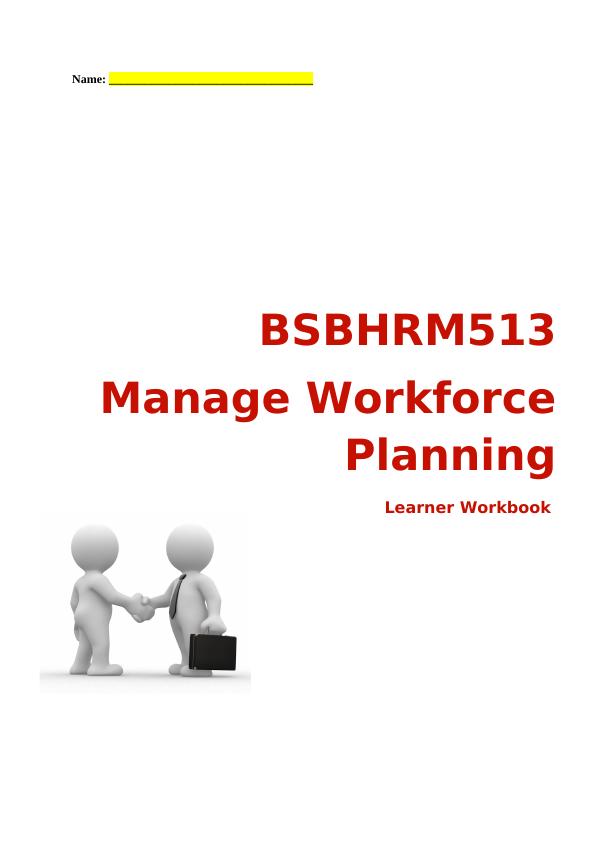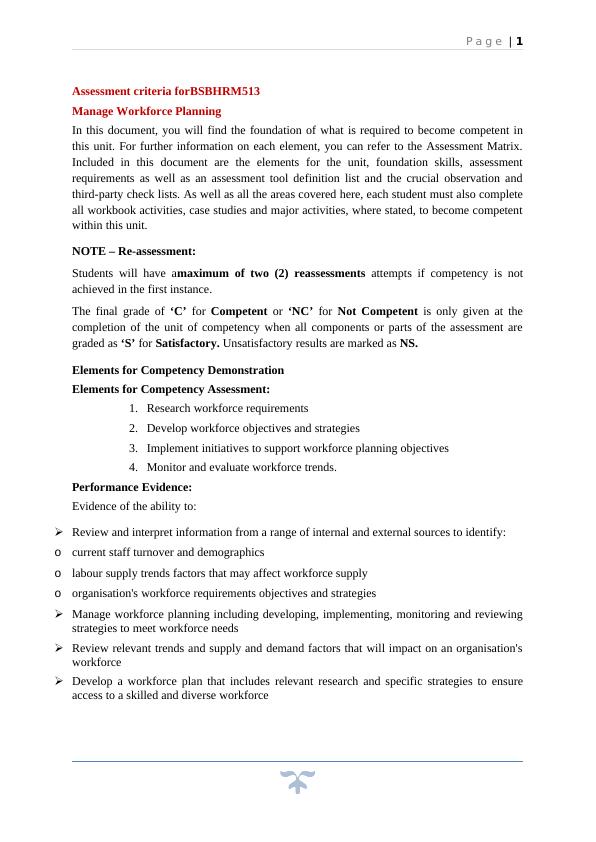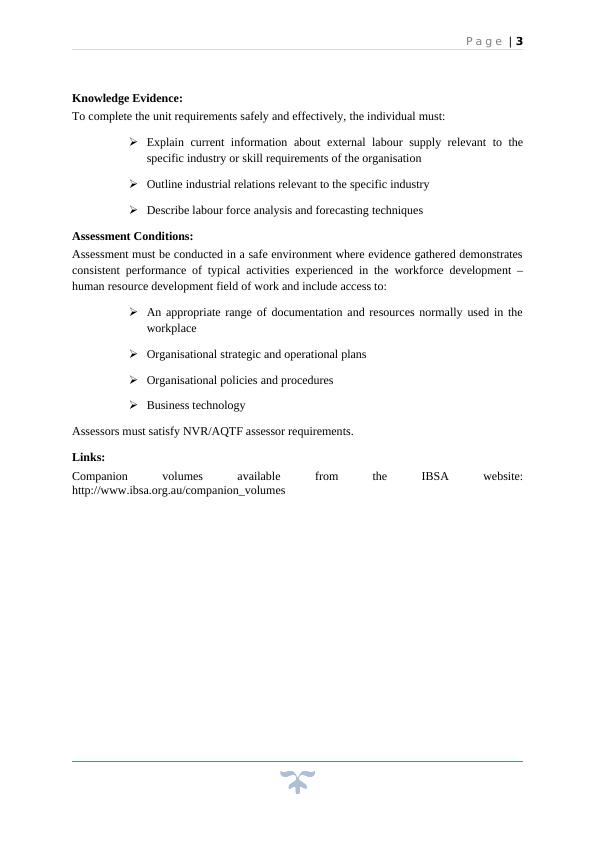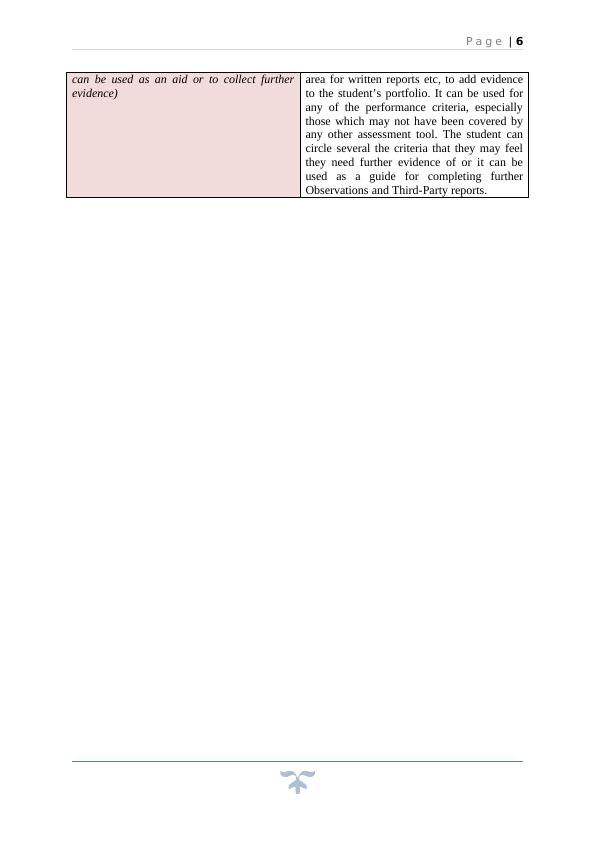BSBHRM513. Manage Workforce Planning
Added on 2022-08-21
51 Pages6788 Words15 Views
Name: __________________________________
BSBHRM513
Manage Workforce
Planning
Learner Workbook
BSBHRM513
Manage Workforce
Planning
Learner Workbook

P a g e | 1
Assessment criteria forBSBHRM513
Manage Workforce Planning
In this document, you will find the foundation of what is required to become competent in
this unit. For further information on each element, you can refer to the Assessment Matrix.
Included in this document are the elements for the unit, foundation skills, assessment
requirements as well as an assessment tool definition list and the crucial observation and
third-party check lists. As well as all the areas covered here, each student must also complete
all workbook activities, case studies and major activities, where stated, to become competent
within this unit.
NOTE – Re-assessment:
Students will have amaximum of two (2) reassessments attempts if competency is not
achieved in the first instance.
The final grade of ‘C’ for Competent or ‘NC’ for Not Competent is only given at the
completion of the unit of competency when all components or parts of the assessment are
graded as ‘S’ for Satisfactory. Unsatisfactory results are marked as NS.
Elements for Competency Demonstration
Elements for Competency Assessment:
1. Research workforce requirements
2. Develop workforce objectives and strategies
3. Implement initiatives to support workforce planning objectives
4. Monitor and evaluate workforce trends.
Performance Evidence:
Evidence of the ability to:
Review and interpret information from a range of internal and external sources to identify:
o current staff turnover and demographics
o labour supply trends factors that may affect workforce supply
o organisation's workforce requirements objectives and strategies
Manage workforce planning including developing, implementing, monitoring and reviewing
strategies to meet workforce needs
Review relevant trends and supply and demand factors that will impact on an organisation's
workforce
Develop a workforce plan that includes relevant research and specific strategies to ensure
access to a skilled and diverse workforce
Assessment criteria forBSBHRM513
Manage Workforce Planning
In this document, you will find the foundation of what is required to become competent in
this unit. For further information on each element, you can refer to the Assessment Matrix.
Included in this document are the elements for the unit, foundation skills, assessment
requirements as well as an assessment tool definition list and the crucial observation and
third-party check lists. As well as all the areas covered here, each student must also complete
all workbook activities, case studies and major activities, where stated, to become competent
within this unit.
NOTE – Re-assessment:
Students will have amaximum of two (2) reassessments attempts if competency is not
achieved in the first instance.
The final grade of ‘C’ for Competent or ‘NC’ for Not Competent is only given at the
completion of the unit of competency when all components or parts of the assessment are
graded as ‘S’ for Satisfactory. Unsatisfactory results are marked as NS.
Elements for Competency Demonstration
Elements for Competency Assessment:
1. Research workforce requirements
2. Develop workforce objectives and strategies
3. Implement initiatives to support workforce planning objectives
4. Monitor and evaluate workforce trends.
Performance Evidence:
Evidence of the ability to:
Review and interpret information from a range of internal and external sources to identify:
o current staff turnover and demographics
o labour supply trends factors that may affect workforce supply
o organisation's workforce requirements objectives and strategies
Manage workforce planning including developing, implementing, monitoring and reviewing
strategies to meet workforce needs
Review relevant trends and supply and demand factors that will impact on an organisation's
workforce
Develop a workforce plan that includes relevant research and specific strategies to ensure
access to a skilled and diverse workforce

P a g e | 2
Foundation Skills:
Reading
Interprets and critically analyses organisational strategy and data on staff
turnover and demographics
Writing
Uses broad vocabulary, grammatical structure and conventions appropriate to
audience and context to develop strategies, plans or reports
Oral communication
Conveys information using language, format and style appropriate to a
specific audience
Numeracy
Extracts and evaluates the mathematical information and applies
mathematical and problem-solving strategies when monitoring labour trends
and surveying organisational climate
Navigate the world of work
Understands and interprets organisational goals to develop processes,
objectives or strategies relevant to own role requirements
Interact with others
Selects and implements appropriate communication protocols to liaise with
personnel in a range of work contexts
Get the work done
Sequences and schedules complex activities, monitors implementation and
manages relevant communication when researching requirements and
developing workforce objectives and strategies
Makes a range of critical and non-critical decisions in relatively complex
situations, taking a range of constraints into account when assessing factors
affecting workforce supply
Anticipates potential problems and uses analytical or lateral thinking
processes to formulate contingency plans
Uses a range of digital tools to collect data, and to extract, organise and share
information
Foundation Skills:
Reading
Interprets and critically analyses organisational strategy and data on staff
turnover and demographics
Writing
Uses broad vocabulary, grammatical structure and conventions appropriate to
audience and context to develop strategies, plans or reports
Oral communication
Conveys information using language, format and style appropriate to a
specific audience
Numeracy
Extracts and evaluates the mathematical information and applies
mathematical and problem-solving strategies when monitoring labour trends
and surveying organisational climate
Navigate the world of work
Understands and interprets organisational goals to develop processes,
objectives or strategies relevant to own role requirements
Interact with others
Selects and implements appropriate communication protocols to liaise with
personnel in a range of work contexts
Get the work done
Sequences and schedules complex activities, monitors implementation and
manages relevant communication when researching requirements and
developing workforce objectives and strategies
Makes a range of critical and non-critical decisions in relatively complex
situations, taking a range of constraints into account when assessing factors
affecting workforce supply
Anticipates potential problems and uses analytical or lateral thinking
processes to formulate contingency plans
Uses a range of digital tools to collect data, and to extract, organise and share
information

P a g e | 3
Knowledge Evidence:
To complete the unit requirements safely and effectively, the individual must:
Explain current information about external labour supply relevant to the
specific industry or skill requirements of the organisation
Outline industrial relations relevant to the specific industry
Describe labour force analysis and forecasting techniques
Assessment Conditions:
Assessment must be conducted in a safe environment where evidence gathered demonstrates
consistent performance of typical activities experienced in the workforce development –
human resource development field of work and include access to:
An appropriate range of documentation and resources normally used in the
workplace
Organisational strategic and operational plans
Organisational policies and procedures
Business technology
Assessors must satisfy NVR/AQTF assessor requirements.
Links:
Companion volumes available from the IBSA website:
http://www.ibsa.org.au/companion_volumes
Knowledge Evidence:
To complete the unit requirements safely and effectively, the individual must:
Explain current information about external labour supply relevant to the
specific industry or skill requirements of the organisation
Outline industrial relations relevant to the specific industry
Describe labour force analysis and forecasting techniques
Assessment Conditions:
Assessment must be conducted in a safe environment where evidence gathered demonstrates
consistent performance of typical activities experienced in the workforce development –
human resource development field of work and include access to:
An appropriate range of documentation and resources normally used in the
workplace
Organisational strategic and operational plans
Organisational policies and procedures
Business technology
Assessors must satisfy NVR/AQTF assessor requirements.
Links:
Companion volumes available from the IBSA website:
http://www.ibsa.org.au/companion_volumes

P a g e | 4
Any observations and practical assessments must be recorded in the observation checklist.
All practical tasks should be demonstrated during the length of the course. As the instructor,
you must maintain a record demonstrating the date of the practical activities and any
comments relevant to the performance of each student. Where a student is not able to
demonstrate competence in a practical observation activity, further questioning should be put
in its place.
As the instructor, you could be assessing the student’s literacy, numeracy and language skills,
as well as the content and context of his/her answers.
In some cases, you will have to adjust and amend the assessment tools, using different and
varied methods (such as oral assessment), to allow students to be assessed according to their
needs and abilities.
Any observations and practical assessments must be recorded in the observation checklist.
All practical tasks should be demonstrated during the length of the course. As the instructor,
you must maintain a record demonstrating the date of the practical activities and any
comments relevant to the performance of each student. Where a student is not able to
demonstrate competence in a practical observation activity, further questioning should be put
in its place.
As the instructor, you could be assessing the student’s literacy, numeracy and language skills,
as well as the content and context of his/her answers.
In some cases, you will have to adjust and amend the assessment tools, using different and
varied methods (such as oral assessment), to allow students to be assessed according to their
needs and abilities.

P a g e | 5
Assessment Tool Definitions
Assessment Tool How is it used? What is it?
Learner Workbook Activities
(Entire completion is required)
Each student should be given a Learner
Workbook which will hold several activities,
both formative and summative, that all need
to be completed in conjunction with the
appropriate sessions. The PowerPoint,
Learner Guide and instructor should provide
further information to help with the
activities.
Observation/Demonstration
(To be completed for each numbered point as
stated on the checklist)
An observation should be completed for each
of the students by the instructor. If the tasks
aren’t everyday actions, a simulated
environment is acceptable, or a
demonstration can be set up. An observation
checklist can be found at the end of this
document.
Major Activity
(Entire completion is required)
A Major Activity is a summative assessment
and can be found in the Learner Workbook,
after all the activities are completed. This is
an extended piece of summative assessment
which should take anywhere between 1-2
hours and every student should complete this
work. It is a requirement for each unit to
check knowledge and understanding.
Skills and Knowledge Activity
(Entire completion is required)
A Skills and Knowledge Activity is a
summative assessment and is found before
the Major Activity in the Learner Workbook.
This should take between 1-2 hours and
every student should complete this work. It
is a requirement for each unit to check
knowledge and understanding of the
foundation skills and knowledge evidence.
Case Study
(Entire completion is required)
Not all units will have Case Studies but those
that do will be clearly stated within the
PowerPoint and the Learner Workbook. It
will appear as any other activity, but it will
be named ‘Case Study’ and will provide an
example of a possible real-life situation for
the learner to read, interpret and then answer
questions on.
Learner Guide
(To be used as an informational guide)
The Learner Guide links with the Learner
Workbook as it provides the information
given during sessions and more. It can help
students to further their knowledge and to
also complete the activities.
Evidence Document
(Not a necessity for completion of unit but
The Evidence Document lists all the
Elements and Performance Criteria with an
Assessment Tool Definitions
Assessment Tool How is it used? What is it?
Learner Workbook Activities
(Entire completion is required)
Each student should be given a Learner
Workbook which will hold several activities,
both formative and summative, that all need
to be completed in conjunction with the
appropriate sessions. The PowerPoint,
Learner Guide and instructor should provide
further information to help with the
activities.
Observation/Demonstration
(To be completed for each numbered point as
stated on the checklist)
An observation should be completed for each
of the students by the instructor. If the tasks
aren’t everyday actions, a simulated
environment is acceptable, or a
demonstration can be set up. An observation
checklist can be found at the end of this
document.
Major Activity
(Entire completion is required)
A Major Activity is a summative assessment
and can be found in the Learner Workbook,
after all the activities are completed. This is
an extended piece of summative assessment
which should take anywhere between 1-2
hours and every student should complete this
work. It is a requirement for each unit to
check knowledge and understanding.
Skills and Knowledge Activity
(Entire completion is required)
A Skills and Knowledge Activity is a
summative assessment and is found before
the Major Activity in the Learner Workbook.
This should take between 1-2 hours and
every student should complete this work. It
is a requirement for each unit to check
knowledge and understanding of the
foundation skills and knowledge evidence.
Case Study
(Entire completion is required)
Not all units will have Case Studies but those
that do will be clearly stated within the
PowerPoint and the Learner Workbook. It
will appear as any other activity, but it will
be named ‘Case Study’ and will provide an
example of a possible real-life situation for
the learner to read, interpret and then answer
questions on.
Learner Guide
(To be used as an informational guide)
The Learner Guide links with the Learner
Workbook as it provides the information
given during sessions and more. It can help
students to further their knowledge and to
also complete the activities.
Evidence Document
(Not a necessity for completion of unit but
The Evidence Document lists all the
Elements and Performance Criteria with an

P a g e | 6
can be used as an aid or to collect further
evidence)
area for written reports etc, to add evidence
to the student’s portfolio. It can be used for
any of the performance criteria, especially
those which may not have been covered by
any other assessment tool. The student can
circle several the criteria that they may feel
they need further evidence of or it can be
used as a guide for completing further
Observations and Third-Party reports.
can be used as an aid or to collect further
evidence)
area for written reports etc, to add evidence
to the student’s portfolio. It can be used for
any of the performance criteria, especially
those which may not have been covered by
any other assessment tool. The student can
circle several the criteria that they may feel
they need further evidence of or it can be
used as a guide for completing further
Observations and Third-Party reports.

P a g e | 7
Observation/Demonstration
Throughout this unit, the learner will be expected to show their competency of the elements
through observations or demonstrations. The observations and demonstrations will be
completed as well as the formative and summative assessments found in the Learner
Workbook. An explanation of demonstrations and observations:
Demonstration is off-the-job
A demonstration will require:
Performing a skill or task that is asked of you
Undertaking simulation exercise
Observation is on-the-job
The observation will usually require:
Performing a work-based skill or task
Interaction with colleagues and/or customers
The observation/demonstration will take place either in the workplace or the training
environment, depending on the task to be undertaken and whether it is an observation or
demonstration. Each task must be observed. You will need to ensure you provide the learner
with the correct equipment and/or materials to complete the task. You will also need to
inform the learner of the time they have to complete the task; this will once again vary,
depending on the task.
Learner should be able to demonstrate they can:
Research workforce requirements
Develop workforce objectives and strategies
Implement initiatives to support workforce planning objectives
Monitor and evaluate workforce trends
Learners should also demonstrate the following skills:
Reading
Writing
Oral communication
Numeracy
Navigate the world of work
Interact with others
Get the work done
Observation/Demonstration
Throughout this unit, the learner will be expected to show their competency of the elements
through observations or demonstrations. The observations and demonstrations will be
completed as well as the formative and summative assessments found in the Learner
Workbook. An explanation of demonstrations and observations:
Demonstration is off-the-job
A demonstration will require:
Performing a skill or task that is asked of you
Undertaking simulation exercise
Observation is on-the-job
The observation will usually require:
Performing a work-based skill or task
Interaction with colleagues and/or customers
The observation/demonstration will take place either in the workplace or the training
environment, depending on the task to be undertaken and whether it is an observation or
demonstration. Each task must be observed. You will need to ensure you provide the learner
with the correct equipment and/or materials to complete the task. You will also need to
inform the learner of the time they have to complete the task; this will once again vary,
depending on the task.
Learner should be able to demonstrate they can:
Research workforce requirements
Develop workforce objectives and strategies
Implement initiatives to support workforce planning objectives
Monitor and evaluate workforce trends
Learners should also demonstrate the following skills:
Reading
Writing
Oral communication
Numeracy
Navigate the world of work
Interact with others
Get the work done

End of preview
Want to access all the pages? Upload your documents or become a member.
Related Documents
BSBHRM513 Manage Workforce Planning Assignmentlg...
|51
|6787
|24
BSBHRM513 Manage Workforce Planninglg...
|51
|7249
|80
Develop and Manage Performance Management Processes Learnerlg...
|58
|13212
|11
BSBMGT615 Contribute to Organisation Developmentlg...
|58
|13303
|442
BSBMGT616 Develop and Implement Strategic Plans - Assessment Criterialg...
|66
|11512
|103
Manage Performance Management Assignmentlg...
|48
|10005
|201